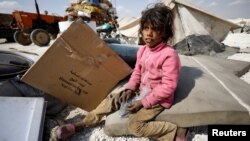Relative calm reported in Syria safe zones after deal comes into force
| Publisher | Radio Free Europe/Radio Liberty |
| Publication Date | 6 May 2017 |
| Cite as | Radio Free Europe/Radio Liberty, Relative calm reported in Syria safe zones after deal comes into force, 6 May 2017, available at: https://www.refworld.org/docid/59818d6010.html [accessed 20 May 2023] |
| Disclaimer | This is not a UNHCR publication. UNHCR is not responsible for, nor does it necessarily endorse, its content. Any views expressed are solely those of the author or publisher and do not necessarily reflect those of UNHCR, the United Nations or its Member States. |
May 06, 2017 11:54 GMT
By RFE/RL
 An internally displaced girl who fled Raqqa city sits inside a camp in Ain Issa, in Raqqa Governorate, on May 4.
An internally displaced girl who fled Raqqa city sits inside a camp in Ain Issa, in Raqqa Governorate, on May 4.
Wide parts of Syria have enjoyed relative calm despite sporadic clashes after a deal to set up "de-escalation zones" mostly within opposition-controlled areas went into effect, opposition activists and government media outlets said.
There were no immediate reports of casualties after the plan – sponsored by Russia, Turkey, and Iran – went into effect at midnight.
Also on May 6, a text detailing the agreement was published by Russia's Foreign Ministry.
The establishment of safe zones after talks held in Kazakhstan's capital, Astana, earlier this week is the latest effort to reduce violence amid a six-year civil war that has left more than 400,000 dead and is the first to envisage armed foreign monitors on the ground in Syria.
However, the United States is not part of the deal, and the Syrian armed opposition refused to sign it, saying that Iran, which it considers a party in the conflict, should not be a guarantor.
According to the text of the document published by the Russian Foreign Ministry on May 6, Russia, Turkey, and Iran agreed to establish four separate de-escalation zones in Syria for at least six months.
The largest safe zone includes Syria's Idlib Province and adjoining districts of Hama, Aleppo, and Latakia provinces.
The other three zones are in northern Homs Province, the Eastern Ghouta region east of the capital, Damascus, and along the Jordanian border in southern Syria.
Russia, Turkey, and Iran will finalize maps of the de-escalation zones by June 4, and the agreement can be extended automatically if the three guarantors agree.
The memorandum provides for halting the hostilities between Syrian government forces and armed opposition groups within the safe zones, allowing humanitarian access, medical assistance, as well as the return of displaced civilians to their homes and the restoration of damaged infrastructure.
The three guarantor states will continue fighting Islamic State, the Al-Nusra Front, and other groups both within and beyond the de-escalation zones, according to the document.
Russia and Iran are key allies of President Bashar al-Assad's government.
Political and armed opposition groups in Syria have rejected the proposal, saying Russia has been unwilling or unable to get Assad and his Iranian-backed militia allies to respect past cease-fires.
Turkey is a major backer of opposition factions and has also sent troops into northern Syria.
It is also not clear how the safe zones will be enforced.
Russian Colonel General Sergei Rudskoi told reporters on May 5 that personnel from Russia, Iran, and Turkey will operate checkpoints and observation posts.
An official with Russia's military general staff said other countries may eventually have a role in enforcing the de-escalation areas.
Meanwhile, there were limited reports of bombing in northern Homs and Hama, and the southern province of Daraa, areas expected to be part of the "de-escalation zones," activists said. There were no immediate reports of casualties.
Still, opposition activists in southern, central, and northern Syria said the situation so far is better than previous days, with no air strikes reported.
The government-controlled Syrian Central Military Media reported there was "relative calm" in the "de-escalation zones" nine hours after the deal went into effect.
The Britain-based Syrian Observatory for Human Rights, which has activists around the country, said government helicopter gunships dropped three barrel bombs on the rebel-held Latamneh area in central Syria, where fighting was reported between rebels and troops.
Government forces also bombarded rebel-held neighborhoods of Damascus, the observatory said.
"Despite some violations, the situation is much calmer than before," said opposition activist Mohammed al-Homsi, speaking via Skype from northern Syria.
Syrian, Russian, Turkish, and U.S.-led coalition aircraft sometimes operate in the same areas in Syria. It is not yet clear how the new plan would affect flight paths of coalition warplanes battling IS militants and other radical groups – and whether U.S. warplanes would abide by a diminished airspace.
The Pentagon said the de-escalation agreement would not affect the U.S.-led air campaign against IS.
A previous cease-fire agreement that went into effect on December 30 helped reduce overall violence in Syria for several weeks but eventually collapsed. Other attempts at a cease-fire in Syria have all ended in failure.
Link to original story on RFE/RL website
